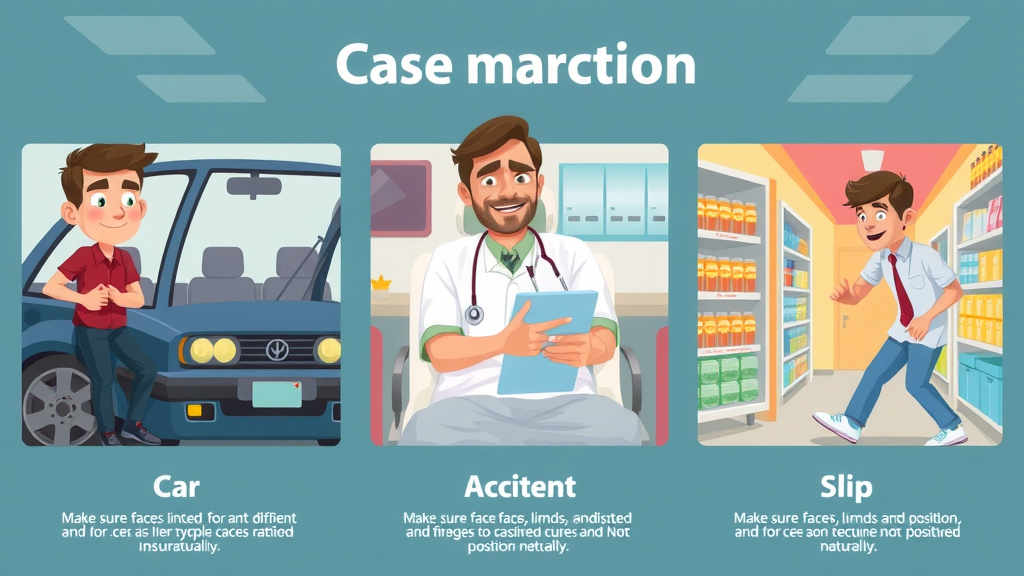Ever wondered, ‘How long does a personal injury case take?’ The answer isn’t as simple as you might think. With timelines ranging from weeks to several years, it’s crucial to understand the factors influencing your claim and what you can do to ensure the process moves as smoothly as possible. Whether you’re worried about mounting medical bills or feel daunted by insurance companies, getting clear on how long it takes to settle an injury case can save you stress and help you protect your rights. Let’s uncover what really determines the pace of a personal injury case and how you can actively shape the outcome.

How Long Does a Personal Injury Case Take? Your Ultimate Guide to Timelines, Claims, and Lawsuits
- Ever wondered, "How long does a personal injury case take?" Discover the crucial factors that determine the length of personal injury cases and what can speed up—or slow down—the process.
Key Insights and What You'll Learn About How Long a Personal Injury Case Takes
- The average timeline for personal injury cases from claim to settlement
- Factors affecting how long a personal injury case takes
- Key differences between injury claim, personal injury lawsuit, and injury case duration
- How injury law, insurance companies, and injury lawyers impact timeframes
- Essential tips for navigating your personal injury claim efficiently
Factors That Affect How Long a Personal Injury Case Takes
Understanding the Basics: What is a Personal Injury Case?
- Defining a personal injury case according to injury law
- Types of personal injury cases: car accidents, slip and fall, medical malpractice
- Main parties involved: injury lawyers, insurance companies, and courts
A personal injury case is a legal dispute that arises when someone suffers harm from an accident or injury and someone else might be legally responsible for that harm under personal injury law . Common types include car accidents , slip and fall incidents , and medical malpractice claims. The three central parties in any injury case are the injured person (plaintiff), the entity or person allegedly responsible (defendant), and often, an insurance company tasked with paying out any compensation. Navigating this terrain often requires the help of an injury lawyer who understands the complexities of personal injury claims and can advocate for a fair settlement.
Each personal injury claim is unique, with timelines shaped by injury severity, dispute over fault, and the willingness of the parties to negotiate. While most cases settle out of court, some escalate into a personal injury lawsuit —potentially stretching out the process. Understanding these basics prepares you to ask the right questions about how long your injury case might take and why getting prompt, professional legal support can make all the difference in bringing your claim to a successful resolution.

The Typical Timeline: From Filing a Personal Injury Claim to Settlement
- Step-by-step overview: injury claim initiation, investigation, negotiation, lawsuit filing
- Key milestones: consultation with personal injury attorney, discovery phase, mediation
- The role of medical improvement and maximum medical improvement in delays
The timeline for a personal injury case usually starts with filing a personal injury claim with the relevant insurance company . This phase includes investigating the incident, gathering evidence, and determining liability. A critical step follows: seeking medical care and reaching what’s called maximum medical improvement (MMI) , when your long-term prognosis becomes clear and future medical bills can be more accurately estimated. Only then can your injury lawyer assess the true value of your claim and begin settlement negotiations.
If negotiations with an insurance company stall, your case may proceed to a formal personal injury lawsuit . This introduces additional steps—discovery, depositions, and potentially, trial preparation. At every stage, cooperation between you, your injury attorney , and medical providers is essential for timely progress. Every action or delay can add weeks or even months to the process, highlighting the importance of informed, persistent legal guidance.
| Phase | Estimated Duration | Main Activities |
|---|---|---|
| Claim Filing | 2 weeks – 3 months | Case Review, Medical Evaluation, Documentation |
| Negotiations with Insurance Company | 1 – 6 months | Offer Assessment, Demand Letters, Counteroffers |
| Trial Preparation (if lawsuit filed) | 6 months – 1 year | Discovery, Depositions, Evidence Gathering |
| Trial | 1 day – 2 weeks | Presenting Case in Court |
| Settlement | Anytime until Trial or After Verdict | Final Negotiations, Disbursement |
Common Delays: Why Do Some Personal Injury Cases Take Longer Than Others?
Medical Treatment Duration and Maximum Medical Improvement
- Waiting for maximum medical improvement and its impact
- Complex injuries and ongoing treatment
- How personal injury lawyers evaluate fair settlement post-MMI
One major delay in any personal injury case is waiting for maximum medical improvement (MMI) . Doctors use this milestone to mark when your injuries have healed as much as possible, or your condition has stabilized. This is vital because a fair settlement should cover all past, present, and future medical bills . If you settle before reaching MMI, you might not be compensated for ongoing treatments or unexpected complications.
More severe or complicated injuries naturally extend the length of injury cases . Ongoing care, surgeries, or rehabilitation can create delays, as can doctors’ schedules and waiting for specialist opinions. Personal injury lawyers strategically wait for MMI to demand the right settlement, ensuring that you aren’t left paying out of pocket for lingering health problems related to your accident. It’s a careful balance—waiting too long can be stressful, but acting too soon risks leaving money on the table.
Insurance Company Negotiations and Disputes
- Procedural delays caused by insurance company tactics
- Disputes over liability or damages
- Dealing with settlement offers and counteroffers
Negotiating with the insurance company often brings its own set of delays. Insurers may purposely slow the process—delaying responses, requesting extra paperwork, or making low initial settlement offers (known as “lowballing”). These tactics are designed to protect their bottom line rather than your interests. Worse, if there is any dispute about fault or the seriousness of your injuries, expect added delays as both sides engage in back-and-forth discussions, evaluations, and counteroffers.
During this time, your injury lawyer must carefully build your case with strong documentation: medical records, wage loss statements, and expert testimony. If early offers aren’t fair, standing your ground—even if it takes longer—is crucial to securing a settlement that truly covers your losses under injury law . Remember, the timeline is as much about protecting your future as it is about reaching a quick resolution.

Legal Complexities in Personal Injury Lawsuits
- Steps in a personal injury lawsuit and litigation timeline
- Discovery process and deposition delays
- Court backlog and trial scheduling challenges
Should your personal injury case evolve into a personal injury lawsuit —typically because negotiations fail—expect the timeline to be extended. Filing suit brings structured phases like discovery, where each side gathers facts and takes sworn witness statements called depositions. It’s not uncommon for complexities or disputes during discovery to add months to the process, especially if new issues arise or more evidence is requested. The workload for both your injury attorney and the defense increases dramatically at this stage, making experienced legal representation more important than ever.
Additionally, logistical issues like waiting for court hearings or dealing with a backlog in busy jurisdictions can further stretch the duration of your suit. If your case goes to trial, the process can take more than a year, especially for complex matters like medical malpractice or cases requiring extensive expert input. Understanding these potential roadblocks helps set realistic expectations and underscores why it’s so vital to work with a seasoned personal injury lawyer who can push for progress and keep your interests at the forefront.
The Role of Personal Injury Lawyers and Experienced Legal Representation
How Experienced Personal Injury Attorneys Speed Up or Slow Down Cases
- Choosing a qualified injury lawyer or attorney
- How personal injury lawyers handle insurance negotiations
- When to seek help from an experienced personal injury attorney
Having the right personal injury lawyer dramatically influences how long your injury case takes. Experienced personal injury attorneys know how to gather records quickly, streamline communication with the insurance company , and push back on delay tactics. Conversely, underqualified or overwhelmed lawyers may inadvertently slow the process, missing important deadlines or failing to negotiate aggressively.
When you hire an injury attorney with a proven record, you’re more likely to secure a fair settlement without protracted disputes. Look for law firms offering robust support teams, clear communication policies, and transparent timelines. Whether through skillful negotiation or assertive litigation, an experienced personal injury lawyer protects your interests—including your time, your health, and your wallet.
“An experienced personal injury lawyer can negotiate efficiently with insurance companies and help avoid unnecessary delays—maximizing your compensation within a reasonable timeframe.” — Puget Sound Injury Law

Case Evaluation and the Importance of a Free Case Review
- Benefits of a free case evaluation with personal injury attorneys
- Understanding your personal injury claim’s strengths and weaknesses
- What to expect from an initial consultation
Before diving into the complexities of an injury case , schedule a free case evaluation with a personal injury lawyer . A case review can clarify whether your personal injury claim is viable, outline expected timelines, and reveal potential hurdles—such as disputed liability or difficulty proving damages. During this consultation, your personal injury attorney will assess evidence, discuss strategy, and recommend next steps tailored to your case’s specifics.
This process shines a light on your injury claim’s strengths and weaknesses, equipping you to make informed decisions. Many reputable law firms and injury lawyers offer this initial evaluation with no obligation, ensuring that you understand your options before committing. Don’t underestimate the value of a seasoned expert’s perspective—it can save you critical time and help secure a better outcome from the start.
Realistic Expectations: How Long Does a Personal Injury Case Take to Settle?
- Typical settlement timelines: injury claim vs. personal injury lawsuit
- Short-term vs. long-term cases
- Elements unique to personal injury law influencing the duration
The honest answer to “ how long does a personal injury case take ?” is: it depends. Simple personal injury claims may resolve in as little as 2–6 months, especially where liability is clear and injuries are minor. However, personal injury lawsuits —especially those involving serious injuries, complex fault issues, or multiple parties—can last 1–3 years or even longer.
Unique factors in personal injury law , such as state statutes of limitations, comparative or contributory negligence rules, and the willingness of parties to negotiate, all play roles. Short-term cases often feature quick medical recovery, cooperative insurance companies , and clear liability; long-term cases involve contested claims, disagreement over damages, or difficult-to-prove losses. Set your expectations based on honest, ongoing conversations with your injury attorney , and don’t be tempted by a quick but inadequate settlement offer if your damages are significant or still being calculated.
Comparing Different Types of Injury Cases: Complexity and Timelines
| Case Type | Low Complexity Claims | High Complexity/Lawsuits |
|---|---|---|
| Car Accident | 3–6 months | 1–2 years |
| Slip and Fall | 3–8 months | 1–2 years |
| Medical Malpractice | 6–12 months | 2–4 years |
- Which personal injury cases are resolved quickly?
- What injury cases regularly require a lawsuit?
- Role of the insurance company in expediting or delaying different scenarios

As these timelines reveal, straightforward car accident claims and uncomplicated slip and fall cases often settle quickly, especially with prompt documentation and responsive insurance companies . Conversely, medical malpractice claims almost always require extensive expert input, multiple reviews, and lengthy legal wrangling, making them among the slowest to resolve. Ultimately, insurance companies play a pivotal role in either expediting or delaying each injury case based on their willingness to negotiate, the clarity of evidence, and the approach of your injury lawyer .
Maximizing Your Chances: Winning a Personal Injury Lawsuit
- Essential strategies for a successful personal injury claim
- Evidence, documentation, and witness importance in injury law
- Role of experienced personal injury lawyers in winning injury cases
Your best path to a successful personal injury case (and faster resolution) is rock-solid preparation. Keep thorough documentation— medical records, police reports, photographs, witness contact information —and follow your doctor’s treatment plan precisely. When necessary, leverage expert witnesses to prove damages or clarify complex injuries. Strong, well-organized evidence often compels insurance companies to settle fairly rather than risk losing at trial under injury law .
Experienced personal injury lawyers are invaluable, both in making a case compelling and in pushing negotiations along. If your claim does escalate to a personal injury lawsuit , their courtroom strategies, understanding of procedural rules, and reputation with insurance companies can all tip the balance in your favor—helping you not only win but win efficiently and with fewer delays.
Video Guide: Success Stories – Personal Injury Case Wins
How to Speed Up Your Personal Injury Case
- Tips for working with personal injury lawyers and insurance companies
- Responding efficiently to requests for evidence and documents
- Proactive medical treatment and documentation
- Negotiation tactics for a fair settlement
If you want to move your personal injury case along as quickly as possible, start by choosing a responsive injury lawyer . Communicate openly—return calls and emails promptly, and provide requested medical records or documentation as soon as possible. The faster your injury attorney can compile evidence, the sooner negotiations with the insurance company can begin or advance.
Stay proactive with your medical treatment . Attend all doctor’s appointments and follow recommendations carefully. This not only protects your health but creates a strong paper trail that proves your damages. Work closely with your law firm to strategize for a fair settlement : prepare a demand letter, consider counteroffers seriously, and don’t shy away from talking through all your options with your legal team. The key to faster cases? Teamwork, thoroughness, and prompt action—every step of the way.

People Also Ask
How long does a personal injury case take to settle?
- The time to settle a personal injury case varies from weeks to years depending on factors such as case complexity, injury severity, investigation, negotiations, and whether a lawsuit is filed. Simple injury claims may resolve in a few months, while personal injury lawsuits can take one to three years or longer.
What are the chances of winning a personal injury lawsuit?
- Success rates for personal injury lawsuits depend on strong evidence, expert testimony, and effective legal representation. Statistics show claimants with injury lawyers win more frequently and secure higher settlements than those without professional help.
How long does it take to process a personal injury claim?
- Processing times for personal injury claims can range from a few weeks to six months on average. Cases involving significant injuries or disputes may take longer. Fast processing usually depends on prompt documentation and insurance company cooperation.
Top Frequently Asked Questions: Personal Injury Law, Claims, and Cases
- What is the first step after an injury case occurs?
- Do all personal injury claims go to court?
- When should I hire a personal injury attorney?
- How do insurance companies assess injury claims?
- What are common reasons for injury lawsuit delays?
Top Takeaways on How Long a Personal Injury Case Takes
- Most personal injury cases settle out of court within months, but preparation for a lawsuit can extend the timeline.
- Complex injury cases or those with liability disputes often take longer to resolve.
- Experienced personal injury lawyers help streamline the process and secure fair settlements more efficiently.
Video Explainer: How to Choose the Right Personal Injury Lawyer for Your Case
Ready to Take the Next Step in Your Personal Injury Case Journey?
- Learn more: visit pugetsoundinjurylaw.com/ for in-depth injury law resources, free case evaluations, and to consult with experienced personal injury lawyers.
Act quickly, stay proactive, and partner with an experienced personal injury lawyer to improve your odds of a fair, timely case outcome.
Understanding the duration of a personal injury case is crucial for managing expectations and planning accordingly. The timeline can vary significantly based on factors such as the complexity of the case, the severity of injuries, and the legal processes involved.
For instance, in Pennsylvania, straightforward personal injury claims often settle within 6 to 12 months if liability is clear and medical treatments are complete. However, cases that proceed to trial may extend from 18 to 36 months due to the discovery process, pre-trial motions, and potential court backlogs. ( jminjurylawyer.com )
Similarly, in Florida, the timeline for a personal injury case can range from a few months to several years. On average, most cases take between 12 to 18 months to resolve. Factors influencing this duration include the severity of injuries, the willingness of the insurance company to settle, and whether the case goes to trial. ( myprivateattorney.com )
In California, the duration of a personal injury case can vary widely, typically ranging from three months to two years. This variation depends on the complexity of the case, the severity of injuries, and the efficiency of the legal process. ( kermanillp.com )
It’s important to note that these timelines are approximate and can be influenced by various factors, including the specifics of the case, the parties involved, and the jurisdiction. Consulting with an experienced personal injury attorney can provide a more accurate estimate tailored to your situation.
 Add Row
Add Row  Add
Add 




Write A Comment